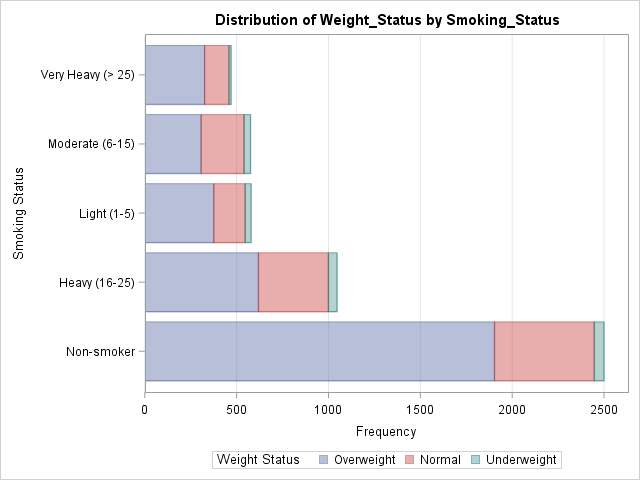I enjoy reading the Graphically Speaking blog because it teaches me a lot about ODS statistical graphics, especially features of the SGPLOT procedure and the Graph Template Language (GTL). Yesterday Sanjay blogged about how to construct a stacked bar chart of percentages so that each bar represents 100%. His chart had the additional feature of displaying the percentages for each category. His post showed how to use the SGPLOT procedure to duplicates the functionality of the G100 option in the GCHART procedure.
See the documentation for the PLOTS= option in the TABLES statement for a description of all the plots that PROC FREQ can create. PROC FREQ creates many plots that are associated with a particular analysis, such as the 'deviation plot,' which shows the relative deviations between the observed and expected counts when you request a chi-square analysis of a one-way table. The PLOTS= option has a common overall syntax for all statistical procedures, but the specific global plot options, plot requests, and plot options vary across procedures. This section discusses only a few of the options available in the PLOTS= option. The first procedure for generating box plots is PROC UNIVARIATE, a Base SAS procedure. To create a box plot of patient pulse data over time, the PLOT option is first included. This causes PROC UNIVARIATE to create a stem-and-leaf plot, a box plot, and a normal probability plot, shown in Figure 2, following the default statistics. 1. Casino stocks. 2 Producing Non-Statistical Graphs Using Base SAS Procedures 1.3 SAS/GRAPH 'SG' Procedures 1.4 Using PROC SGPLOT to Produce Non-Statistical Charts and Plots 1.5 Controlling Graph Appearance with SGPLOT 1.6 Using PROC SGPANEL to Display Multiple Cells Per Page 1.7 Using PROC SGSCATTER to Produce Multiple Plots Per Page. PROC FREQ produces plots by using ODS Graphics to create graphs as part of the procedure output. Frequency plots are available for any frequency or crosstabulation table request.
In this blog post I present an alternative to Sanjay's construction. When I construct a stacked bar chart, I use PROC FREQ to compute the percentages of each category within a group. I then use the VBAR or HBAR statements in the SGPLOT procedure to construct the stacked bar chart. For example, the bar chart at the top of this post is constructed by using the following statements:
The VBAR statement in the SGPLOT procedure creates the stacked bar chart. Each bar totals 100% because the Percent variable from PROC FREQ is used as the argument to the RESPONSE= option. The GROUPDISPLAY=STACK option stacks the groups so that there is one bar per category.

Creating stacked bars ordered by percentages
Occasional made. A variation of the 100% stacked bar chart is to order the 'slices' of the bars by their relative sizes. This is shown at the left. I used the ORDER= option on the PROC FREQ statement to output the counts in descending order for each bar. If I use the GROUPORDER=DATA option on the VBAR statement in PROC SGPLOT, the categories will be arranged and colored according to how they appear in the data. In particular, the first bar will be ordered by relative percentages, as shown by the 'Asia' bar. Notice, however, that this does not guarantee that other bars are ordered by size, as seen by the 'Europe' bar.
Still, I like to order the groups by size because it makes it easier to find the relative percentages of the most important groups. In general, I prefer to order charts by some quantity, rather than to use the default alphabetical ordering.
The following statements produce the 100% stacked bar chart with ordered groups, assuming that the data set is already sorted according to the X variable:
PROC FREQ does it, too! (SAS 9.4m1)
Over the last few releases there have been quite a few new ODS graphs that come out of PROC FREQ 'for free.' If you have SAS 9.4m1, you can use the SCALE=GROUPPERCENT option to create a stacked bar chart similar to the one in the previous section:
The lesson to learn is that you can use relatively simple statements (my post) to produce basic stacked bar charts or more sophisticated SAS code (Sanjay's post) to produce more complicated bar charts. Choose the method that you prefer, and let SAS do the rest.
The recent releases of SAS 9.4 have featured major enhancements to the ODS statistical graphics procedures such as PROC SGPLOT. In fact, PROC SGPLOT (and the underlying Graph Template Language (GTL)) are so versatile and powerful that you might forget to consider whether you can create a graph automatically by using a SAS statistical procedure. For example, when you turn on ODS graphics (ODS GRAPHICS ON), SAS procedures create the following graphs automatically:
- Many SAS regression procedures (and PROC PLM) create effect plots.
- PROC SURVEYREG creates a hexagonal bin plot.
- PROC REG creates heat maps when a scatter plot would suffer from overplotting.
- PROC LOGISTIC creates odds-ratio plots.
Let PROC FREQ visualize your two-way tables
Recently a SAS customer asked how to use PROC SGPLOT to produce a stacked bar chart. I showed him how to do it, but I also mentioned that the same graph could be produced with less effort by using PROC FREQ.
PROC FREQ is a workhorse procedure that can create dozens of graphs. For example, PROC FREQ can create a mosaic plot and a clustered bar chart to visualize frequencies and relative frequencies in a two-way table. Next time you use PROC FREQ, add the PLOTS=ALL option to the TABLES statement and see what you get!
One of my favorite plots for two-way categorical data is the stacked bar chart. As I told the SAS customer, it is simple to create a stacked bar chart in PROC FREQ. For example, the following statements create a horizontal bar chart that orders the categories by frequency:

Creating stacked bars ordered by percentages
Occasional made. A variation of the 100% stacked bar chart is to order the 'slices' of the bars by their relative sizes. This is shown at the left. I used the ORDER= option on the PROC FREQ statement to output the counts in descending order for each bar. If I use the GROUPORDER=DATA option on the VBAR statement in PROC SGPLOT, the categories will be arranged and colored according to how they appear in the data. In particular, the first bar will be ordered by relative percentages, as shown by the 'Asia' bar. Notice, however, that this does not guarantee that other bars are ordered by size, as seen by the 'Europe' bar.
Still, I like to order the groups by size because it makes it easier to find the relative percentages of the most important groups. In general, I prefer to order charts by some quantity, rather than to use the default alphabetical ordering.
The following statements produce the 100% stacked bar chart with ordered groups, assuming that the data set is already sorted according to the X variable:
PROC FREQ does it, too! (SAS 9.4m1)
Over the last few releases there have been quite a few new ODS graphs that come out of PROC FREQ 'for free.' If you have SAS 9.4m1, you can use the SCALE=GROUPPERCENT option to create a stacked bar chart similar to the one in the previous section:
The lesson to learn is that you can use relatively simple statements (my post) to produce basic stacked bar charts or more sophisticated SAS code (Sanjay's post) to produce more complicated bar charts. Choose the method that you prefer, and let SAS do the rest.
The recent releases of SAS 9.4 have featured major enhancements to the ODS statistical graphics procedures such as PROC SGPLOT. In fact, PROC SGPLOT (and the underlying Graph Template Language (GTL)) are so versatile and powerful that you might forget to consider whether you can create a graph automatically by using a SAS statistical procedure. For example, when you turn on ODS graphics (ODS GRAPHICS ON), SAS procedures create the following graphs automatically:
- Many SAS regression procedures (and PROC PLM) create effect plots.
- PROC SURVEYREG creates a hexagonal bin plot.
- PROC REG creates heat maps when a scatter plot would suffer from overplotting.
- PROC LOGISTIC creates odds-ratio plots.
Let PROC FREQ visualize your two-way tables
Recently a SAS customer asked how to use PROC SGPLOT to produce a stacked bar chart. I showed him how to do it, but I also mentioned that the same graph could be produced with less effort by using PROC FREQ.
PROC FREQ is a workhorse procedure that can create dozens of graphs. For example, PROC FREQ can create a mosaic plot and a clustered bar chart to visualize frequencies and relative frequencies in a two-way table. Next time you use PROC FREQ, add the PLOTS=ALL option to the TABLES statement and see what you get!
One of my favorite plots for two-way categorical data is the stacked bar chart. As I told the SAS customer, it is simple to create a stacked bar chart in PROC FREQ. For example, the following statements create a horizontal bar chart that orders the categories by frequency:
See the documentation for the PLOTS= option in the TABLES statement for a description of all the plots that PROC FREQ can create. PROC FREQ creates many plots that are associated with a particular analysis, such as the 'deviation plot,' which shows the relative deviations between the observed and expected counts when you request a chi-square analysis of a one-way table.
Plots Freqplot Sas 3
Do you need a highly customized graph?
The ODS graphics in SAS are designed to create many—but not all—of the visualizations that are relevant to an analysis. Some attributes of a graph (for example, the title and the legend placement) are determined by a stored template and can't be modified by using the procedure syntax. Advanced GTL gurus might want to learn how to edit the ODS templates. Less ambitious users might choose to use a statistical procedure to automatically create graphs during data exploration and modeling, but then use PROC SGPLOT to create the final graph for a report.
For example, the following call to PROC FREQ writes the two-way frequency counts to a SAS data set. From the data you can create graphs that are similar to the one that PROC FREQ creates, but you can change the order and colors of the bars, alter the placement of the legend, add text, and more. The following call to PROC SGPLOT shows one possibility. Click on the graph to see the full-size version.
Plots Freqplot Sas Definition
Conclusions
If you want to create a stacked bar chart or some other visualization of a two-way table, you might be tempted to immediately start using PROC SGPLOT. The purpose of this article is to remind you that SAS statistical procedures, including PROC FREQ, often create graphs as part of their output. Even if a statistical procedure cannot provide all the bells and whistles of PROC SGPLOT, it often is a convenient way to visualize your data during the preliminary stages of an analysis. If you need a highly customized graph for a final report, the SAS procedure can output the data for the graph. You can then use PROC SGPLOT or the GTL to create a customized graph.
